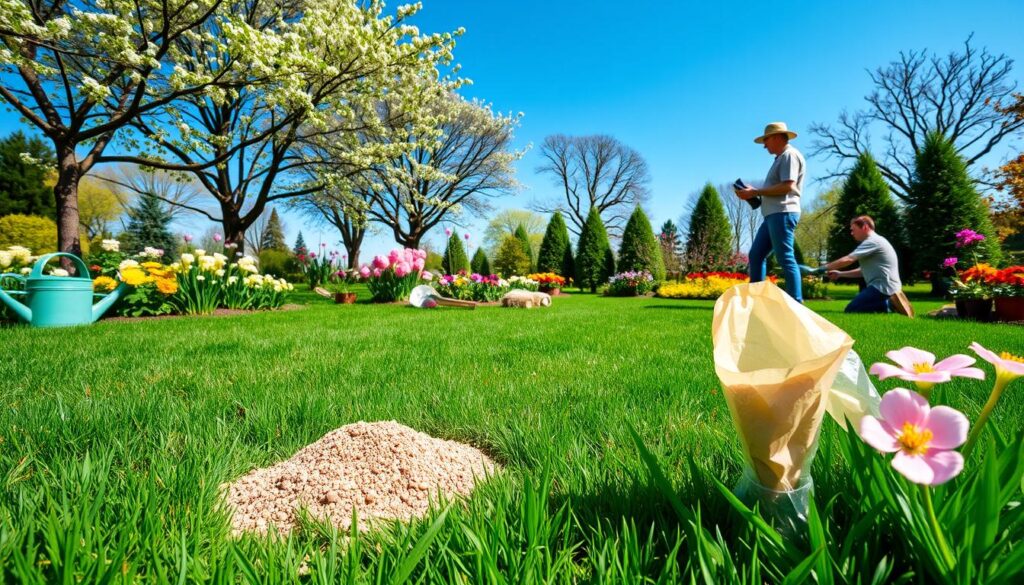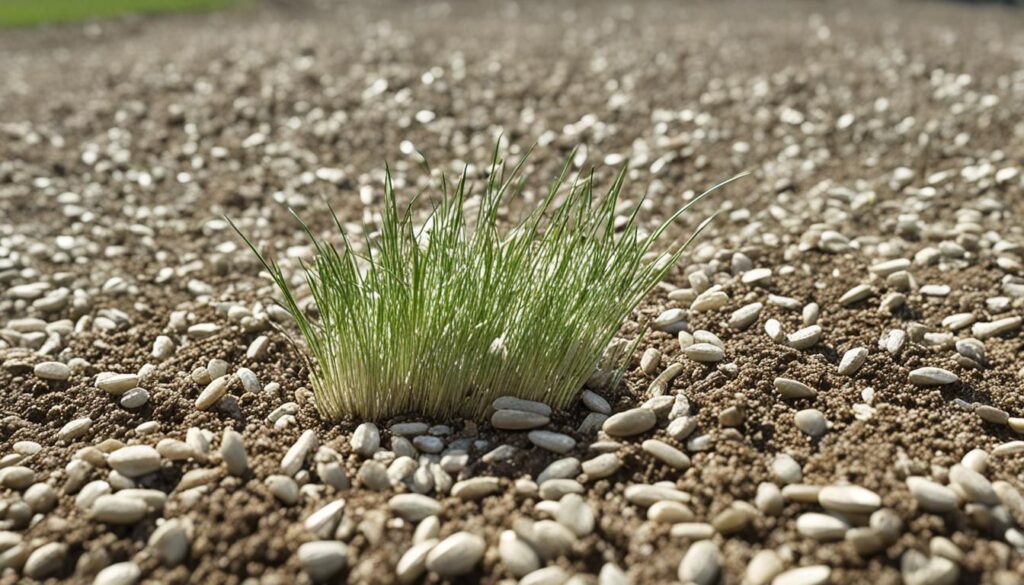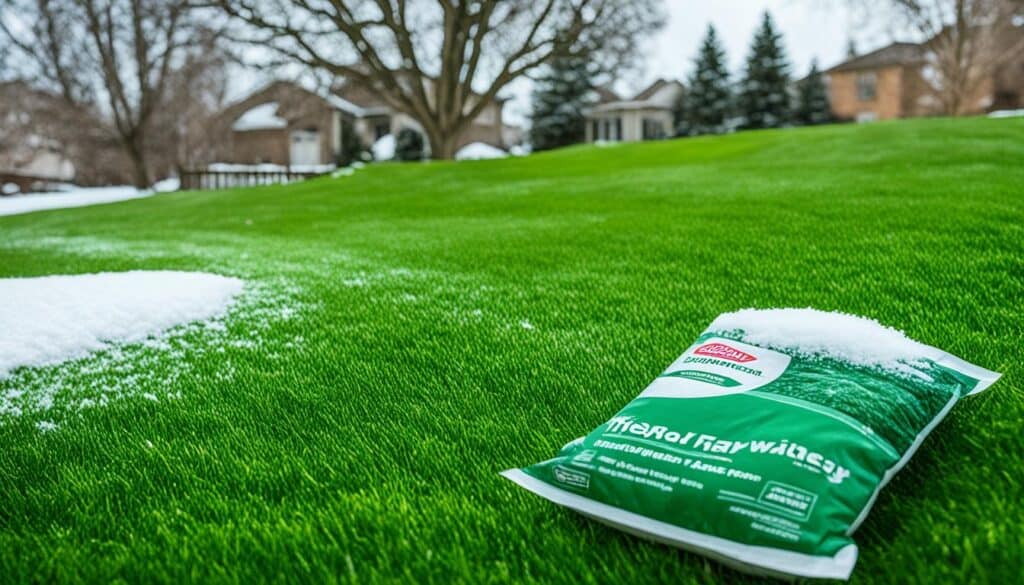Did you know the best time to fertilize your lawn is in spring? It’s when your lawn starts growing strong. To make your lawn healthy all year, it needs special nutrients. Knowing about different fertilizers, like organic and synthetic, is important.
I’ve researched to give you the best advice on spring lawn fertilizer. This article will cover why spring fertilization is key. We’ll also talk about how to pick the right fertilizer for your grass.
Key Takeaways
- Fertilizing your lawn in spring is crucial for promoting healthy growth and preparing it for the growing season
- Slow-release granular fertilizers high in nitrogen are recommended for providing continuous nutrient supply
- Balancing nitrogen, phosphorus, and potassium is key for overall lawn health and a thick, green appearance
- Proper application timing and techniques, such as using a spreader and watering after application, are important for effective results
- Complementary lawn care practices like aeration and overseeding can further enhance the benefits of spring fertilization
Why Fertilize Your Lawn in Spring?
When grass comes out of winter, it needs a nutrient boost. Fertilizing in spring helps it grow healthy and fight weeds. It’s important to fertilize when grass starts growing again.
Importance of Spring Lawn Fertilization
Feeding your lawn four times a year makes it healthier and more beautiful. Use early spring fertilizer from February to April when grass grows. For North areas, Scotts® Turf Builder® Halts Crabgrass Preventer with Lawn Food is good if you had crabgrass last year.
Benefits of a Healthy, Green Lawn
A healthy lawn can handle pests, diseases, and weather better. It looks lush and green, making your home look better. Apply late spring fertilizer from April to June, 6 to 8 weeks after the first feeding.
Most people fertilize once in spring and maybe once or twice more. Chemical fertilizers are still the most popular. You can find them at hardware stores, big-box stores, and garden shops.
Understanding NPK Ratios
Lawn fertilizers often have a ratio of nitrogen (N), phosphorus (P), and potassium (K) on the packaging. This ratio, like 10-10-10 or 20-5-10, shows the percentage of each nutrient. Knowing these numbers helps pick the right fertilizer for your lawn, especially in spring.
Nitrogen (N) helps grass grow strong and green. Phosphorus (P) supports root growth. Potassium (K) helps grass fight off stress and disease. For spring, look for a ratio like 20-0-5, 15-0-6, or 30-0-3, with more nitrogen.
| Nutrient | Percentage Range | Role in Lawn Health |
|---|---|---|
| Nitrogen (N) | 22% to 25% | Promotes lush, green appearance and stimulates root growth |
| Phosphorus (P) | 2% to 3% | Contributes to root system development and energy transfer processes |
| Potassium (K) | 8% to 12% | Plays a role in water absorption, photosynthesis, and overall plant health, crucial for drought tolerance and disease resistance |
Knowing about NPK ratios helps your lawn get the nutrients it needs in spring. This knowledge helps choose the best fertilizer for your lawn.
“The NPK ratio is a crucial factor in selecting the appropriate grass fertilizer, with formulations varying such as 10-10-10, 32-0-10, or 16-4-8.”
Choosing the Right Spring Fertilizer
As the weather warms up, your lawn comes back to life. Choosing the right fertilizer is key for its health and look. You need to decide between slow-release and quick-release, and organic or synthetic fertilizers.
Slow-Release vs. Quick-Release Fertilizers
Slow-release fertilizers feed your grass over months, giving it a steady supply of nutrients. This helps prevent waste and promotes strong roots. Quick-release fertilizers, on the other hand, give a fast boost but don’t last as long.
Experts say to use a slow-release fertilizer high in nitrogen for spring. It supports the grass’s growth without overwhelming it.
Organic vs. Synthetic Fertilizers
Organic fertilizers, like bone meal or compost, improve soil health. They boost microbial activity and help hold nutrients. Synthetic fertilizers offer a quick, precise nutrient boost but may not improve soil as much.
Think about your lawn’s needs and what you prefer. Organic fertilizers are good for a sustainable lawn. Synthetic fertilizers work fast for quick results.
The right fertilizer for your lawn depends on your grass, climate, and goals. Knowing the differences helps you choose the best for your lawn’s success.
What’s the Best Fertilizer to Put on Your Lawn in the Spring?
As the weather gets warmer, your lawn comes out of its sleep. It’s time to pick the best fertilizer for spring. Experts suggest using products with an NPK ratio like 20-0-5, 15-0-6, 30-0-3, or 35-0-5. These formulas have more nitrogen for green growth and balanced phosphorus and potassium.
For spring, choose slow-release granular fertilizers. They feed your lawn slowly over months. This helps your grass grow strong and look healthy. Both synthetic and organic fertilizers, like Milorganite, are great for waking up your lawn.
| Fertilizer Type | NPK Ratio | Recommended For |
|---|---|---|
| Synthetic | 20-0-5 | Promoting green, lush growth |
| Synthetic | 15-0-6 | Balanced nutrition for lawn recovery |
| Organic | 30-0-3 | Revitalizing dormant lawns |
| Synthetic | 35-0-5 | Maximizing green, lush growth |
Choosing the right best fertilizer for spring lawn helps your lawn thrive. Follow the application instructions and consider your soil, grass, and climate for the best results.

“Applying the right top spring lawn fertilizers at the correct time is key to maintaining a healthy, green lawn throughout the growing season.”
Application Tips for Spring Fertilization
Timing is key when applying spring lawn fertilizer. The best time is when the grass is growing fast, usually when soil is between 55-70°F. It’s best to fertilize a few weeks before the grass grows quickly to let the nutrients soak in.
Apply fertilizer when the lawn is dry and there’s rain coming. This helps the fertilizer mix well with the soil. Using a properly set spreader ensures the fertilizer spreads evenly. This avoids burn spots from too much fertilizer in one spot.
Using a Spreader for Even Distribution
Using a spreader is the best way to get even coverage and avoid over-fertilizing. Here are some tips for using a spreader effectively when applying spring lawn fertilizer:
- Calibrate the spreader settings according to the product recommendations on the fertilizer bag.
- Overlap the spreader passes by a few inches to avoid missing any spots.
- Apply the fertilizer in a grid pattern, going back and forth across the lawn.
- Shut off the spreader when making turns at the end of each pass to prevent over-application.
- Clean the spreader thoroughly after use to maintain its performance.
By following these tips, your lawn will get the right amount of fertilizer. This will help it grow well and look lush and healthy all spring and summer.
Complementary Lawn Care Practices
Spring fertilization is key to reviving your lawn. But it’s even better when you add other important lawn care steps. Tasks like aerating, dethatching, and overseeding help your fertilizer work its best. Together, they turn your yard into a lush, healthy oasis.
Aerating and Dethatching
Aerating your lawn before fertilizing is crucial. It makes small holes in the soil. This lets air, water, and nutrients get to the roots better.
Aeration boosts soil oxygen levels. It helps the fertilizer reach the grass plants more effectively.
Dethatching is also vital before spring fertilization. Thatch is dead and living plant matter on the soil surface. It blocks the fertilizer from reaching the roots.
Dethatching removes this buildup. It lets the nutrients get to the grass.
Overseeding Bare Spots
Overseeding in the spring fills in bare or thinning spots. You spread grass seed over the existing turf. This encourages new growth and a lush look.
By overseeding with fertilization, your lawn gets the best chance to thrive. This comprehensive approach ensures your fertilizer investment is worth it. You’ll have a beautifully manicured outdoor space.

Expert Recommendations for Spring Lawn Care
As spring comes, lawn care experts share their top tips for fertilizing your lawn. Steve Peeler, a well-known expert, says using a balanced fertilizer is key. This type of fertilizer has the right mix of nitrogen, phosphorus, and potassium (NPK) for healthy grass.
Peeler warns against too much nitrogen. It can make the grass grow too much, hurting the roots. He suggests using Scotts Turf Builder Thick’R Lawn. It’s a mix of fertilizer, seed, and soil improver that makes your lawn thicker.
Scott McLeod agrees with Peeler, highlighting the importance of timing and how you apply the fertilizer. McLeod says it’s crucial to watch the weather. Fertilizing when it’s the right temperature is key for the best results.
- Use a balanced fertilizer with the appropriate NPK ratio to support overall lawn health
- Avoid over-applying nitrogen, which can lead to excessive foliage growth at the expense of root development
- Consider products like Scotts Turf Builder Thick’R Lawn that combine fertilizer, seed, and soil improver for a comprehensive lawn-care solution
- Pay close attention to weather conditions and apply fertilizer during the recommended temperature range for best results
By taking Peeler and McLeod’s advice, homeowners can give their lawns the care they need to flourish in spring.
Common Mistakes to Avoid
Fertilizing your lawn in spring is key for a lush, healthy landscape. But, there are common mistakes to avoid. Steer clear of these to ensure your lawn thrives all season.
Over-Fertilizing and Potential Risks
One big mistake is using too much fertilizer, especially high-nitrogen types. Too much nitrogen can cause fast growth that attracts pests and diseases. It can also lead to risks of over-fertilizing the lawn, like fertilizer burn and thinning grass.
It’s important to use fertilizer in moderation.
Neglecting Soil Testing
Another mistake is not testing the soil before fertilizing. Soil tests show what nutrients your lawn needs and its pH balance. Without this, you might over or under-fertilize, harming your lawn’s health.
- Regular soil tests reveal your lawn’s exact nutritional needs.
- Choosing the right fertilizer based on soil test results prevents nutrient imbalances and promotes growth.
- The importance of soil testing for lawn health is huge, helping you avoid common lawn care don’ts in spring.
By avoiding these common mistakes and taking steps to fix them, you can have a lush, vibrant lawn all season.
Maintaining a Healthy Lawn Throughout the Season
Starting with spring fertilization is crucial for a vibrant lawn. But, the effort doesn’t end there. To keep your lawn healthy and lush, you must stay active all year.
Remember to mow at the right height, water on schedule, and use weed control and aeration when needed. By being proactive and adjusting your routine with the seasons, your lawn will stay strong. It will also handle environmental challenges better.
Don’t forget to use targeted fertilizers in summer and fall. Also, overseed bare spots in autumn. A year-round lawn care plan is essential for that green, healthy look. With some effort and the right strategy, you can have a beautiful lawn all season.
FAQ
Why is it important to fertilize my lawn in the spring?
Fertilizing your lawn in the spring gives it the nutrients it needs. This helps the grass grow strong and healthy. It also makes your lawn more resistant to pests and diseases.
What are the benefits of having a healthy, green lawn?
A healthy lawn looks great and can make your home more valuable. It also fights off weeds and pests better. This means it can handle the growing season more easily.
What do the NPK numbers on lawn fertilizers mean?
The NPK numbers tell you the fertilizer’s nitrogen, phosphorus, and potassium levels. Nitrogen helps the grass grow leaves. Phosphorus supports the roots. Potassium helps the grass stay healthy under stress.
What type of spring lawn fertilizer should I use?
For spring, use a slow-release granular fertilizer. Look for one with a lot of nitrogen, like 20-0-5 or 35-0-5. These fertilizers feed the grass as it grows and keep it balanced.
When is the best time to apply spring lawn fertilizer?
Apply fertilizer when the grass is growing fast, usually when it’s 55-70°F. Fertilize a few weeks before the grass grows quickly. This lets the nutrients soak in.
What other lawn care practices should I do in conjunction with spring fertilization?
Along with fertilizing, aerate, dethatch, and overseed your lawn. These steps help the fertilizer work better and improve your lawn’s health.
What are some common mistakes to avoid when fertilizing my lawn in the spring?
Don’t overdo it with nitrogen-heavy fertilizers. This can make your lawn too lush and vulnerable. Also, test your soil regularly to get the right nutrients.



